Under Langstone Bridge
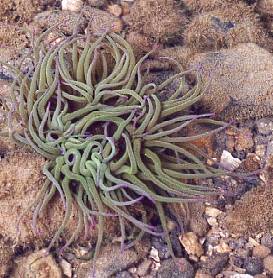 The shore under the bridge to Hayling
Island is a good place to look for sea-life not found on the muddy parts of
Langstone Harbour. It may be partly because the currents between
Langstone and Chichester Harbours scour the sea-bed. The bridge supports and
various lumps of brick and concrete provide hard surfaces on which animals can
anchor themselves. Another factor may be the reduced light levels under the
bridge.
The shore under the bridge to Hayling
Island is a good place to look for sea-life not found on the muddy parts of
Langstone Harbour. It may be partly because the currents between
Langstone and Chichester Harbours scour the sea-bed. The bridge supports and
various lumps of brick and concrete provide hard surfaces on which animals can
anchor themselves. Another factor may be the reduced light levels under the
bridge.
A low spring tide will give the greatest exposure, but any low tide will reveal some interesting features.
A variety of seaweeds can be found on the concrete south of the Ship Inn car
park. Three brown seaweeds Spiral Wrack, Bladder Wrack and Toothed Wrack occupy
progressively lower levels on the shore. Lower down are the red seaweeds. The most obvious green seaweed in the harbour is Grass Kelp Enteromorpha intestinalis.. A more descriptive name is Gut Weed, because of the sausage shapes in the fronds. Another common green seaweed in the harbour is Sea Lettuce, one of the more edible seaweeds.
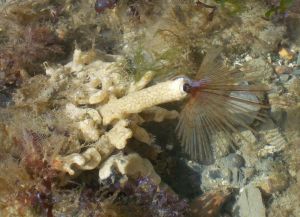
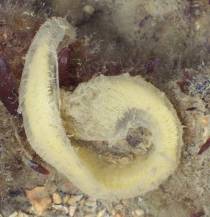 In pools under the bridge are at least two species of sea anemone. The Beadlet Anemone is a
dark red blob when not covered by water, and shrinks further when you touch it.
The Snakelocks Anemone (above left) is more adventurous and will cling to your
fingers.
In pools under the bridge are at least two species of sea anemone. The Beadlet Anemone is a
dark red blob when not covered by water, and shrinks further when you touch it.
The Snakelocks Anemone (above left) is more adventurous and will cling to your
fingers.
Shown above left is the egg coil of a sea slug. The rather shy Peacock Worm, pictured above right, has a delicate fan of tentacles which are rapidly withdrawn if threatened. The tube of this particular animal is almost entirely covered by a sponge, probably Halichondria bowerbanki.
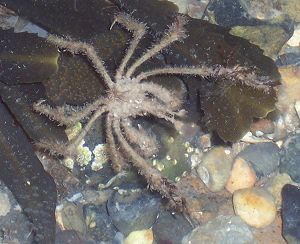 Crabs, shrimps, fish and sea slugs may be found. Pictured left is a Long-legged Spider Crab, possibly Macropodia rostrata or M. tenuirostris. Any comments on this would be appreciated. Compared to the fast-moving Shore Crab, this one is ponderous and easily overlooked.
It uses small pieces of seaweed and other items to break up its shape, making it more difficult to identify.
Crabs, shrimps, fish and sea slugs may be found. Pictured left is a Long-legged Spider Crab, possibly Macropodia rostrata or M. tenuirostris. Any comments on this would be appreciated. Compared to the fast-moving Shore Crab, this one is ponderous and easily overlooked.
It uses small pieces of seaweed and other items to break up its shape, making it more difficult to identify.
On the bridge piers is the barnacle, Elminius modestus, which arrived during World War II on boats from New Zealand.
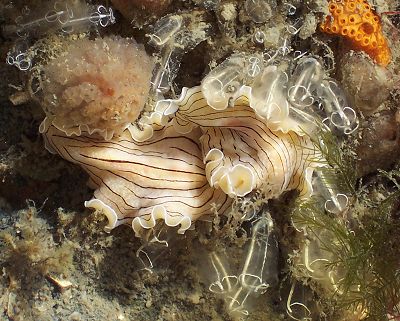 On the right is a Candy-stripe Flatworm, Prostheceraeus vittatus apparently feeding on sea squirts.
On the right is a Candy-stripe Flatworm, Prostheceraeus vittatus apparently feeding on sea squirts.
The area around the bridge is popular for bait-digging, and collecting crabs for bait. Sadly, the visibility in the pools under the bridge can easily be ruined by trampling through them and washing out buckets. Most of the species here have to be tough to survive the tides and currents, but are less well adapted to the impact of a wellington boot.
Thanks are due to Bill Farnham from Portsmouth University for bringing this place to our attention and to Lin Baldock of Dorset for help with sponges.
See also the pages on Sea Squirts, More Sea Squirts and one on Sponges.
Back to Sites
 The shore under the bridge to Hayling
Island is a good place to look for sea-life not found on the muddy parts of
Langstone Harbour. It may be partly because the currents between
Langstone and Chichester Harbours scour the sea-bed. The bridge supports and
various lumps of brick and concrete provide hard surfaces on which animals can
anchor themselves. Another factor may be the reduced light levels under the
bridge.
The shore under the bridge to Hayling
Island is a good place to look for sea-life not found on the muddy parts of
Langstone Harbour. It may be partly because the currents between
Langstone and Chichester Harbours scour the sea-bed. The bridge supports and
various lumps of brick and concrete provide hard surfaces on which animals can
anchor themselves. Another factor may be the reduced light levels under the
bridge.
 In pools under the bridge are at least two species of sea anemone. The Beadlet Anemone is a
dark red blob when not covered by water, and shrinks further when you touch it.
The Snakelocks Anemone (above left) is more adventurous and will cling to your
fingers.
In pools under the bridge are at least two species of sea anemone. The Beadlet Anemone is a
dark red blob when not covered by water, and shrinks further when you touch it.
The Snakelocks Anemone (above left) is more adventurous and will cling to your
fingers.
 Crabs, shrimps, fish and sea slugs may be found. Pictured left is a Long-legged Spider Crab, possibly Macropodia rostrata or M. tenuirostris. Any comments on this would be appreciated. Compared to the fast-moving Shore Crab, this one is ponderous and easily overlooked.
It uses small pieces of seaweed and other items to break up its shape, making it more difficult to identify.
Crabs, shrimps, fish and sea slugs may be found. Pictured left is a Long-legged Spider Crab, possibly Macropodia rostrata or M. tenuirostris. Any comments on this would be appreciated. Compared to the fast-moving Shore Crab, this one is ponderous and easily overlooked.
It uses small pieces of seaweed and other items to break up its shape, making it more difficult to identify. On the right is a Candy-stripe Flatworm, Prostheceraeus vittatus apparently feeding on sea squirts.
On the right is a Candy-stripe Flatworm, Prostheceraeus vittatus apparently feeding on sea squirts.